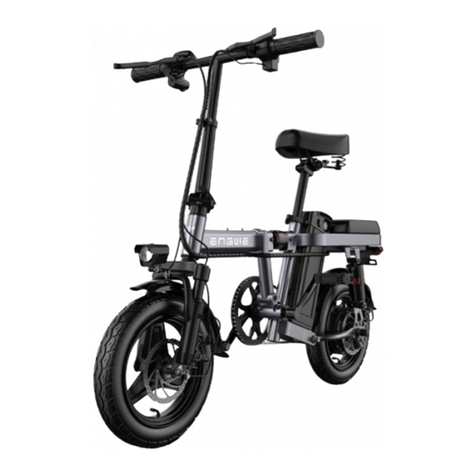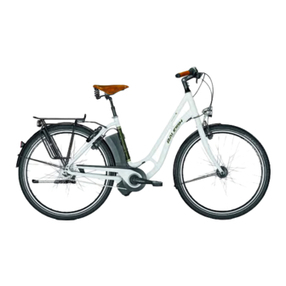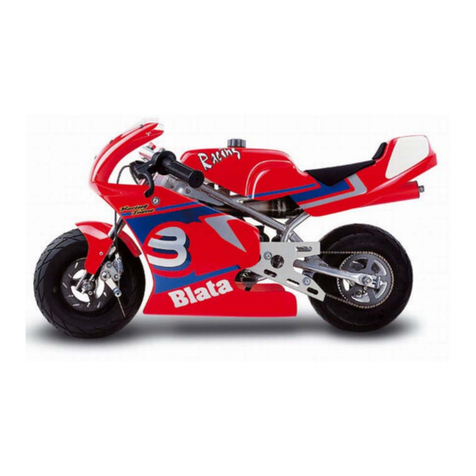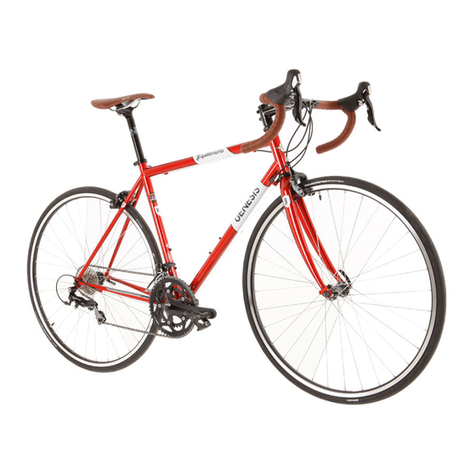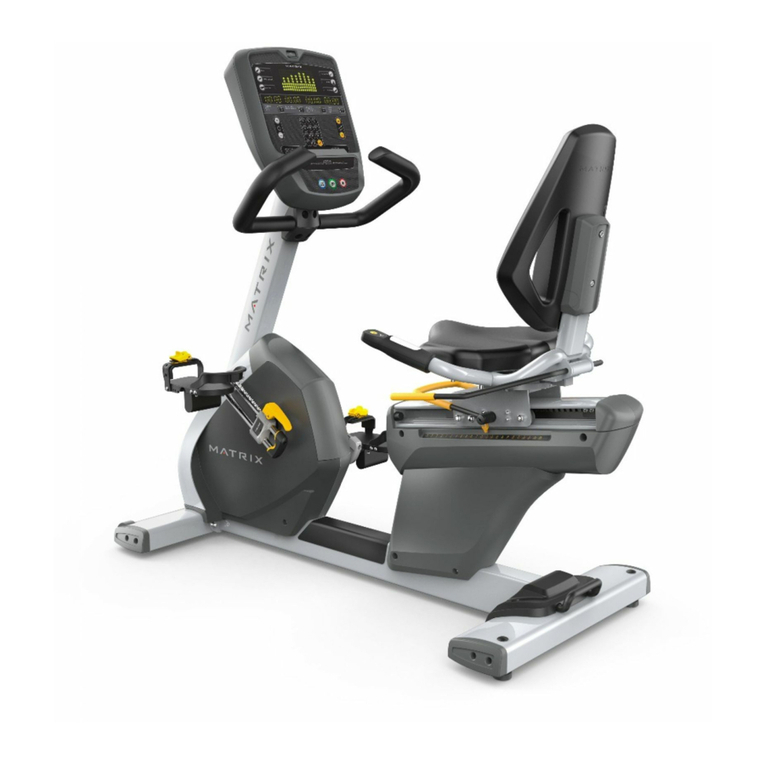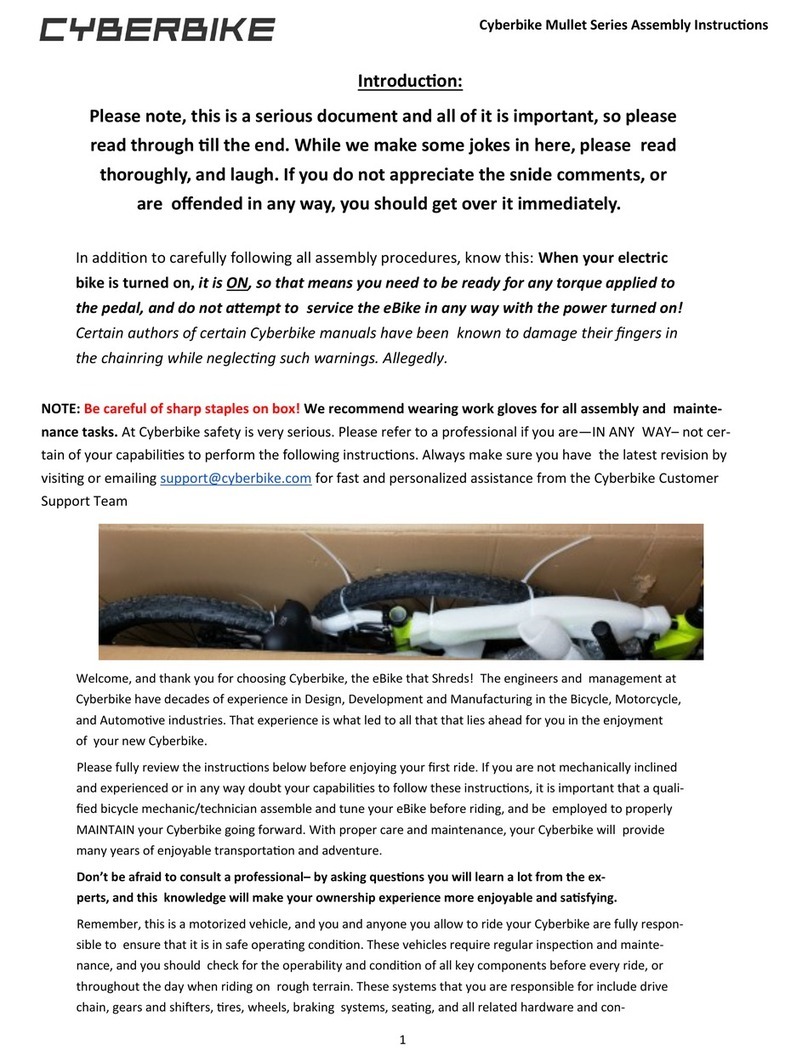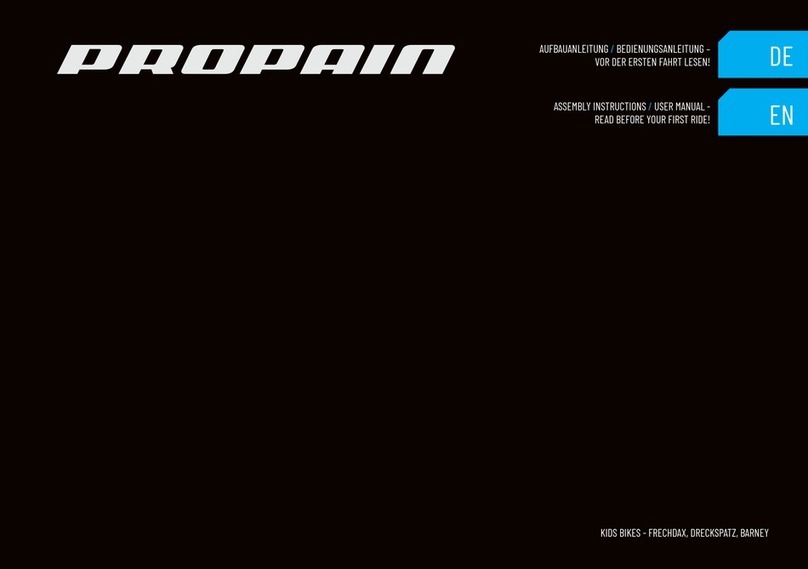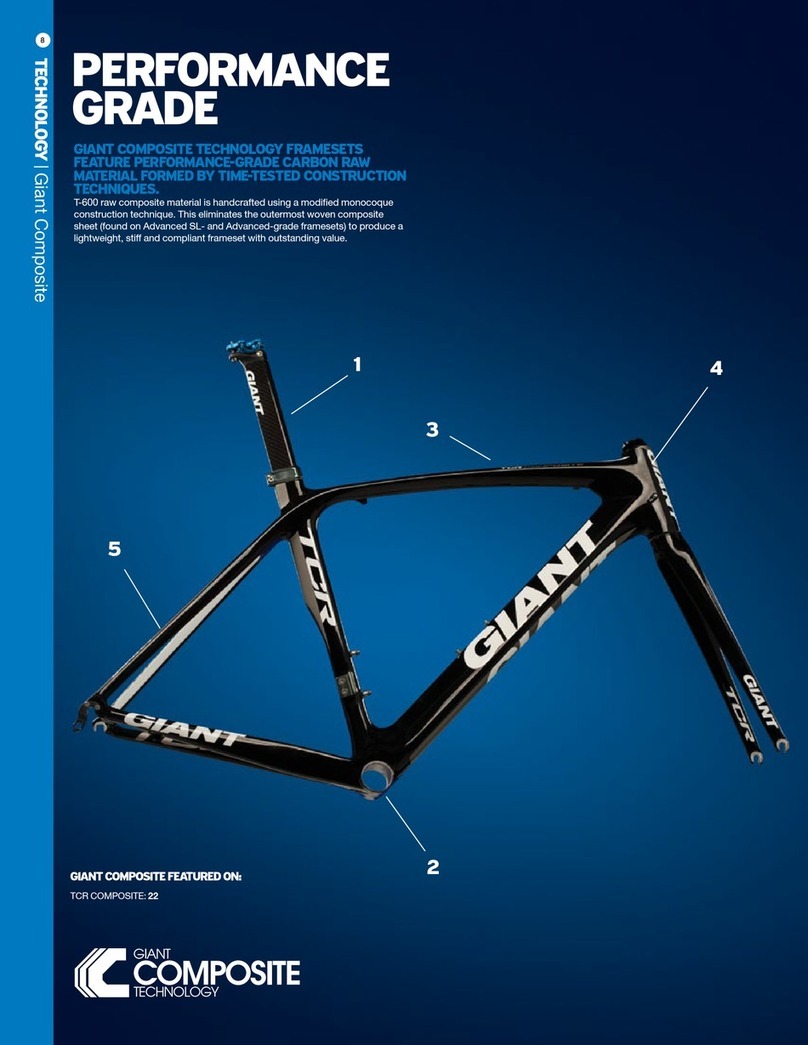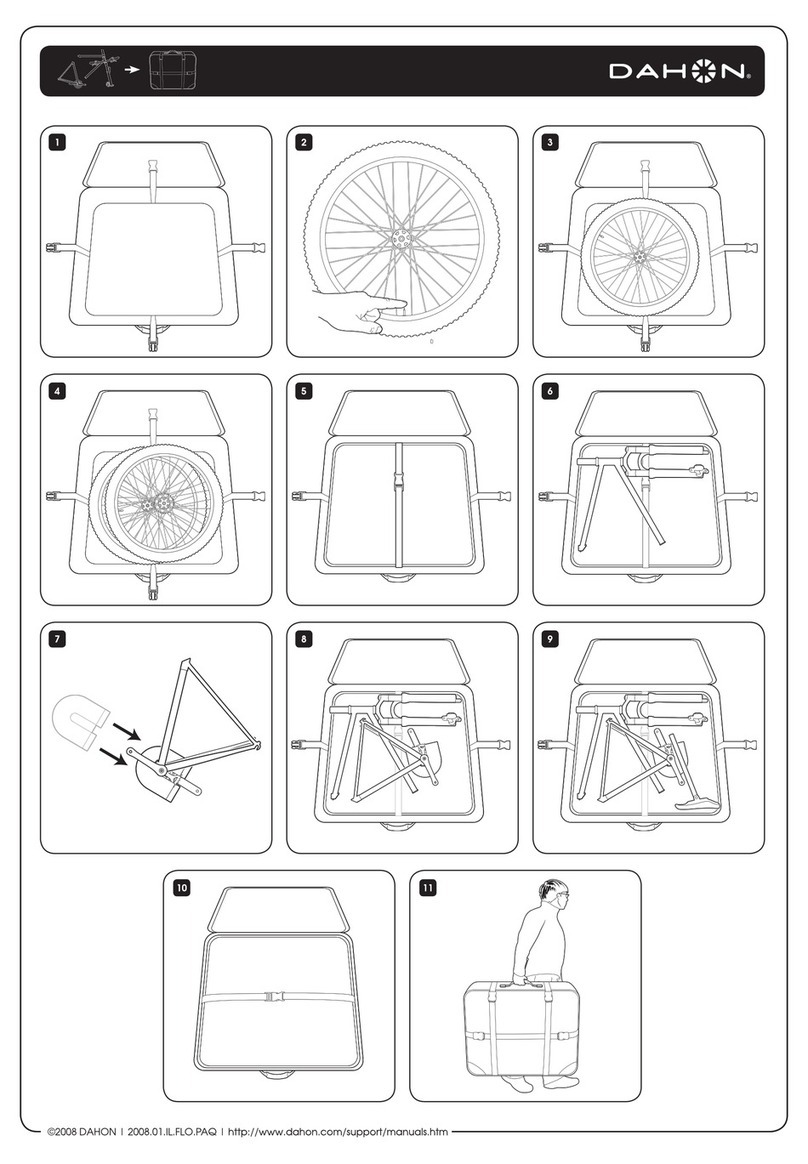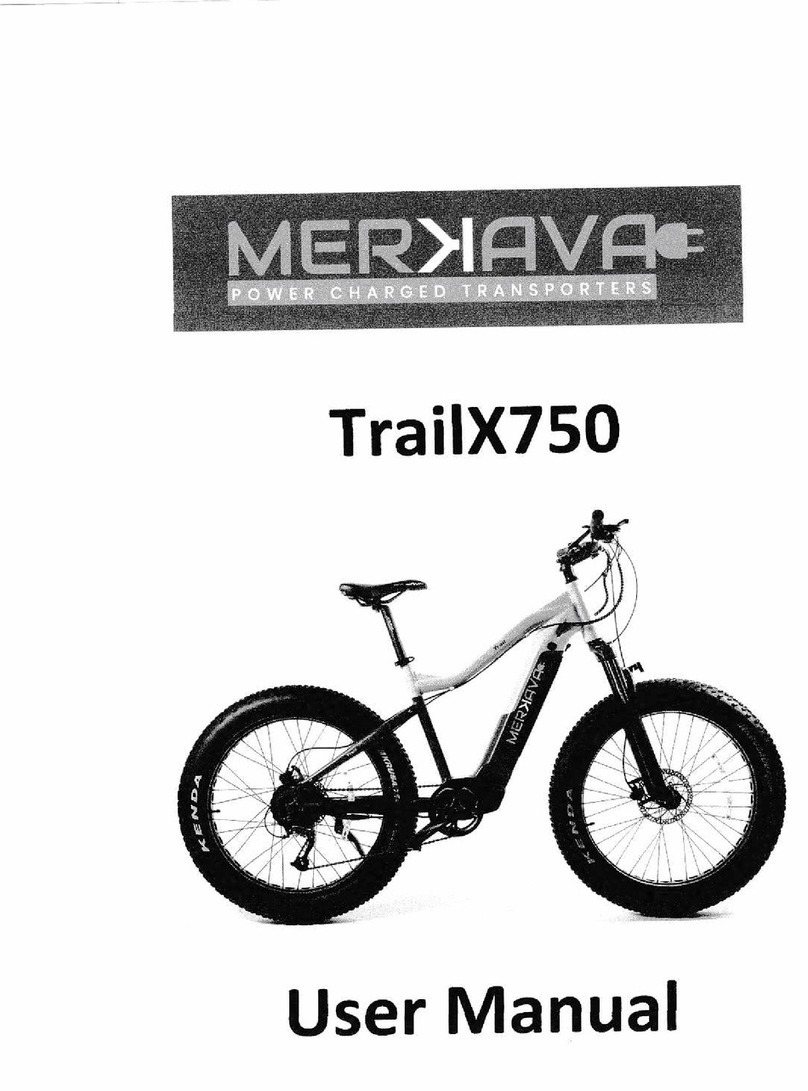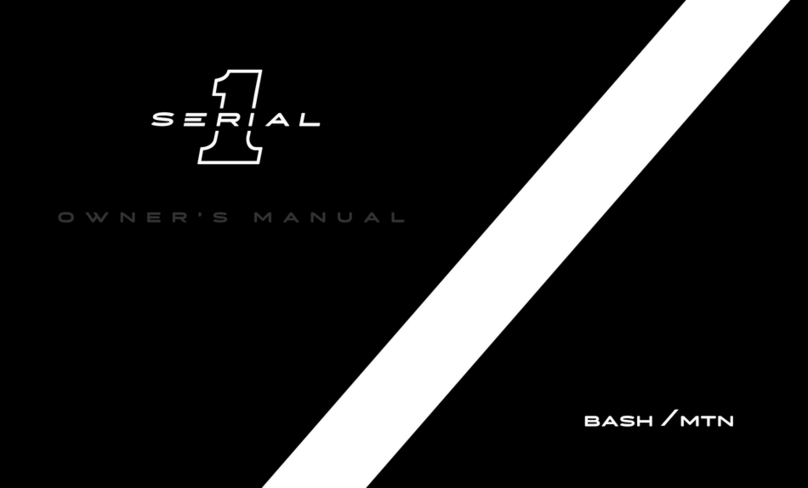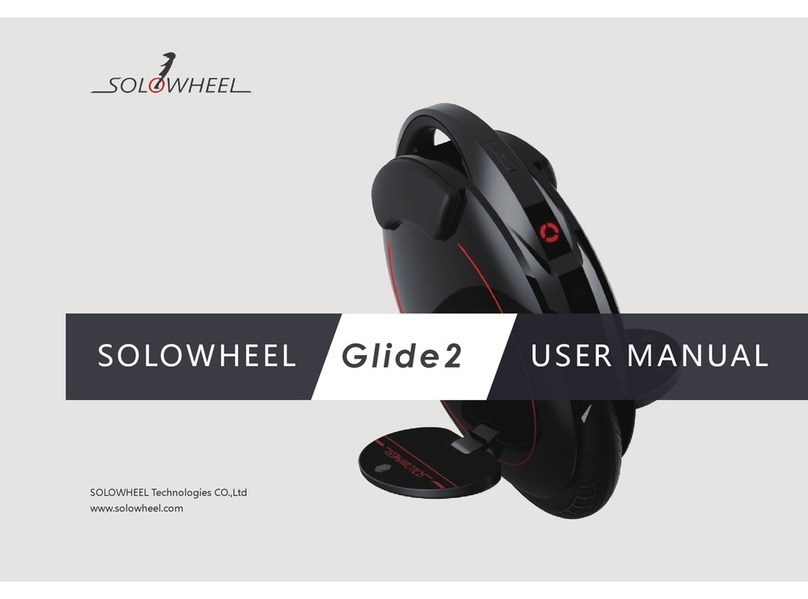Stricker Lipo Smart Series User manual

Additional User Manual
R&E Stricker Reha-Entwicklungen GmbH
Model series
Lipo Smart
Smart Wild
This additional operating manual for the Lipo Smart and Smart Wild model series
supplements the general operating manual for the City, Ultra, Sport, Neodrives, Lipo
Smart and Smart Wild model series.

Manufacturer
R&E Stricker Reha-Entwicklungen GmbH
Klotzberg 64
D-77815 Bühl
Phone: +49 7223/72510
Fax: +49 7223 / 74947
Email: [email protected]
Web: www.stricker-handbikes.de
Subject to misprints, mistakes and price or product changes. Product changes include changes that result from the
further development of the mechanics, the software or the legal requirements.
Date: 10. June 2021
®R&E Stricker Reha-Entwicklungen GmbH , Bühl
Reprinting, even in part, only with the written permission ofR&E Stricker Reha-Entwicklungen GmbH , Bühl.
Notice to reader
For reasons of readability, the masculine form has been chosen in these instructions for use, nonetheless
the information relates to members of all genders.

R&E Stricker Reha-Entwicklungen GmbH
1
Additional instructions for use Lipo Smart, Smart Wild
Inhalt
1 Declaration of Conformity ..................................................................................................................2
2 Introductory Notes .............................................................................................................................2
3 Note on the general instructions for use.............................................................................................2
4 Product description & intended use....................................................................................................2
5 Safety and driving instructions for accident prevention ......................................................................3
5.1 Battery and charger safety instructions ....................................................................................................3
6 Operation ...........................................................................................................................................4
6.1 Lipo Smart range.........................................................................................................................................5
6.2 Smart Wild range.........................................................................................................................................8
7 Battery and charger..........................................................................................................................12
7.1 Charging the battery................................................................................................................................. 12
7.2 Equipment................................................................................................................................................. 12
7.3 Attachment of the battery........................................................................................................................ 12
7.4 Storage...................................................................................................................................................... 13
8 Repair, cleaning and maintenance ....................................................................................................13
8.1 Changing the wheels................................................................................................................................ 13
8.2 Pin assignment......................................................................................................................................... 13
9 Transport .........................................................................................................................................13
9.1 Transport in the vehicle ........................................................................................................................... 14
9.2 Transport by plane ................................................................................................................................... 14
10 Disposal and recycling .....................................................................................................................14
11 Warranty and guarantee ...................................................................................................................14
12 Liability ............................................................................................................................................14
Attachment ............................................................................................................................................16
A Technical data Lipo Smart....................................................................................................................... 16
B Technical data Smart Wild ...................................................................................................................... 17

2
R&E Stricker Reha-Entwicklungen GmbH
Additional instructions for use Lipo Smart, Smart Wild
Declaration of Conformity
1 Declaration of Conformity
The device complies with the current standards and guidelines of the EU. We certify
this in the EC declaration of conformity. If required, we will be happy to send you the
corresponding declaration of conformity. Our power assist devices have been tested by
means of an electromagnetic compatibility test (EMC).
In the event of a change not agreed with R&E Stricker GmbH, this declaration loses its validity.
MDR: We conrm that our products (electric power assist devices and hand-operated wheelchair assist
devices - Stricker Handbikes) comply with the essential requirements according to the new regulation
(EU) 2017/745 (MDR) or the Medical Devices Act. The documentation of the production is available at
the company R&E Stricker Reha-Entwicklungen GmbH. R&E Stricker Reha-Entwicklungen GmbH holds full
responsibility for the issuance of the declaration of conformity.
2 Introductory Notes
WARNING
Please read these operating instructions and all other operating instructions supplied with the handbike
carefully and observe them before using the handbike.
WARNING
Visually impaired people or people with cognitive impairments must have the information material and
the instructions for use read out to them by assistants. Corresponding documents are available on our
website www.stricker-handbikes.de on the Internet. Videos and photos are also available there.
DEALER NOTICE
Be sure to hand over these operating instructions to every customer when handing over the handbike and
expressly draw the customer‘s attention to the safety and hazard information.
Never deliver a handbike without an instruction manual!
3 Note on the general instructions for use
WARNING
These are the additional instructions for use for handbikes of the Lipo Smart model series. It supplements
the general operating instructions for the City, Ultra, Sport, Neodrives and Lipo Smart model series. It is
essential that you read both instructions for use before using the handbike.
4 Product description & intended use
The handbike is coupled to a manual wheelchair as an electrically assisted, manual pulling aid. This
allows the driver to be supported in his mobility. The aim is to expand the radius of action by allowing
longer distances to be covered more easily and independently. Coupling the handbike creates a
three-wheeled vehicle with three relatively large wheels. The handbike therefore improves the driving
characteristics on uneven surfaces. Obstacles can also be overcome more easily. Downhill and uphill
driving is safer thanks to the additional braking systems. The driver can independently couple the
handbike to the wheelchair and detach it from the wheelchair. The wheelchair as such is not changed and
its properties are fully retained.

R&E Stricker Reha-Entwicklungen GmbH
3
Additional instructions for use Lipo Smart, Smart Wild
Safety and driving instructions for accident prevention
5 Safety and driving
instructions for accident
prevention
WARNING
These notes are for your own safety. Please read
these carefully before using the handbike and
observe the instructions! Failure to follow the
instructions for use could result in damage to the
product
and serious personal injury. We do not accept any
liability for damage caused by disregarding the
instructions for use.
NOTE
Observe all safety and hazard notices and
instructions, both in this and in all other
instructions for use supplied.
5.1 Battery and charger safety
instructions
WARNING
Before carrying out repair, cleaning or
maintenance tasks on the handbike, switch off the
electrical components and remove the batteries
from the handbike.
The supplied batteries are only used to operate
the drive systems of the handbike. Do not connect
other systems to the battery. Any use beyond that
requires the written approval of the manufacturer.
All information corresponds to the state of the art
at the time of printing. Cases of abuse include:
• Use of the battery contrary to the description
and information in the instructions for use
• Use of the battery when the technical
performance limits are exceeded
• Technical modication of the battery
• Modication of the battery software
• Use of the battery to power other systems
We assume no liability for damage in the event of
misuse.
HEALTH ADVICE
If you come into contact with escaping gases,
supply fresh air. In case of body contact with
battery uids, rinse the affected part of the body
with plenty of water. Consult a doctor in the
event of contact with mucous membranes or
symptoms.
5.1.1 Operation
Make sure that the batteries are rmly seated in
the holders provided and that the batteries are
locked. This is especially true if you have removed
the batteries from the towing device before
charging.
Pay attention to the battery temperature on the
display during extreme mountain drives. The
temperature must not exceed 45 °C. To prevent
overheating, take a break in operation to relieve
the batteries.
Only operate the battery in ambient temperatures
between -20 °C and 50 °C. Operation outside the
temperature range shortens the service life of the
battery and carries the risk of ignition.
Do not subject the battery to shock. If the
battery has been dropped or has been hit, the
battery must be checked by the manufacturer.
Please contact your specialist dealer or the
manufacturer regarding the return and repair /
disposal procedure. This also applies to otherwise
damaged or defective batteries. Do not continue to
use a damaged or defective battery. Do not open
the battery yourself.
Keep the battery dry and clean. Protect the
battery against the ingress of moisture or foreign
particles. Do not connect the contacts of the
battery with metallic or other conductive objects.
Keep the battery away from small metallic objects
such as screws, coins, paper clips, keys or the like
to avoid a short circuit. Only clean dirty contacts
with a dry, clean cloth. Do not immerse the battery
in water.
If you nd that the battery is overheating, leaking,
smoking, emitting an unusual odor, or becoming
deformed, immediately stop using the battery and
turn off the battery.
Protect the battery from heat and open ames
(radiators, microwaves, ovens, strong sunlight).
Exposure to heat can cause ignition and explosion.

4
R&E Stricker Reha-Entwicklungen GmbH
Additional instructions for use Lipo Smart, Smart Wild
Operation
Do not open the case of the battery. Do not
disassemble the battery. Damage to the battery
cells or contact with oxygen can lead to re and
explosion. Opening the battery voids the warranty.
FIRE FIGHTING
Do not attempt to extinguish lithium-ion batteries
with water or other liquids in the event of a re.
Battery cell manufacturers recommend sand as
the only extinguishing agent. There is a risk of
explosion in a re.
Extinguish lead-gel batteries with water, foam or
CO2. In the event of a re with lead-gel batteries,
dangerous gases can be formed. Under no
circumstances should you inhale the gases.
5.1.2 Charging process
WARNING
Do not leave the battery unattended while
charging.
Only charge the battery at temperatures between
0 and 40 °C. A charging process outside the
temperature range is automatically canceled by
the battery. To optimize the service life, charge the
battery at temperatures of 10-30 °C.
Charge the battery in a sufciently ventilated,
dry and dust-free environment. Make sure there
is sufcient air circulation during the charging
process.
Do not charge the battery in the vicinity of
ammable substances (solids, liquids, gases).
Protect the battery from moisture when charging.
Do not charge the battery in areas where water
could condense on the battery or charger. Only
use the charger when it is completely dry. If
condensation has formed, let the charger dry
completely before charging.
Only use the charger supplied to charge the
battery. Using any other charger could result in
malfunction, damage, defect, ignition or explosion.
Do not charge the battery with a defective charger.
Replace a defective charger immediately.
Do not use a charger that has been shocked
or dropped. Do not open or repair the charger
yourself.
Do not charge damaged batteries.
Avoid unnecessary charging and do not charge the
battery for long periods of time when you are not
using it.
The battery will automatically stop charging as
soon as the battery is fully charged. When the
charging process is complete, rst disconnect the
charger from the mains socket and then from the
battery.
Do not carry the charger by the power cord or the
charging cable. Do not pull on the power cord to
disconnect the charger from the power outlet. Do
not apply pressure to the cables and connectors
or pinch them. There is a risk of electric shock or
ignition.
Position the charger so that nobody can step on or
trip over the cable or charger. Protect the charger
and all associated components from other harmful
inuences or loads.
5.1.3 Storage
Do not store the batteries in places that will be
exposed to heat for a long time (sunlit car trunk,
garden shed, etc.). The service life of the battery
depends, among other things, on the storage
conditions.
Use your car only for transport, not for storing or
keeping the battery.
For an optimal service life, store the battery at
18-23 °C and a maximum humidity of 80%. Do not
expose the battery to moisture (rain, snow, etc.)
when storing it.
Before storing, charge the battery according
to the specications of the respective battery
(“7.4 storage”). Check the charge level at least
every three months and recharge the battery if
necessary.
Make sure that the battery is stored protected
from damage and unauthorized access.
Store the battery out of the reach of children.
6 Operation
WARNING
Switch off the battery when connecting or
disconnecting the wheelchair and maneuvering or
alternatively turn the speed control on the handle
to 0 to prevent unintentional driving off when
moving the cranks.

R&E Stricker Reha-Entwicklungen GmbH
5
Additional instructions for use Lipo Smart, Smart Wild
Operation
6.1 Lipo Smart range
6.1.1 Before driving
NOTE
Unpacking and installation video can be found on
www.stricker-handbikes.de/installationsupport
WARNING
Always remove the key for the key switch when
parking the power assist device in order to
prevent unauthorized use of the device.
Switch on the battery with the main switch on the
battery (Fig. 1). You can tell that the battery is on
when the lamp on the battery is on.
Turn the key switch with the key to the position
“ON” (Fig. 2). Remove the key and stow it securely
so as not to lose it while driving.
Fig. 1: Battery
Fig. 2: Lipo Smart control unit position “ON”
6.1.2 Lipo Smart Para
On the left ergonomic handle you will nd the
thumb throttle for speed control above the grip
surface. With the thumb throttle you can drive 6
or 25 km / h, depending on the version, without
assistance from cranking. If you start to crank,
the thumb throttle will be deactivated. You can
now set the speed using the controller on the
handle. The handbike then moves at the set speed
regardless of how hard you crank.
The brake lever on the left ergonomic handle
automatically interrupts the drive electronics when
pressed. You can therefore not operate the left
brake lever and accelerate with the thumb throttle
at the same time. The brake lever also has a
locking mechanism. Use this to use the brake as a
parking brake.
The brake lever on the right ergonomic handle has
no break contact. You can use the right brake lever
to start off on a hill.
Always use both brake levers to brake.
6.1.3 Lipo Smart Tetra
You can adjust the speed using the chin control
knob.

6
R&E Stricker Reha-Entwicklungen GmbH
Additional instructions for use Lipo Smart, Smart Wild
Operation
To make starting easier, press the traction
help button for one second. The handbike then
supports the start-up process for two seconds
with the preset speed setting.
The Lipo Smart has a coaster brake. Activate this
by turning the handbike cranks backwards. The
exact function of the coaster brake is explained in
the general operating instructions in chapter “12.1
Coaster brake”.
If your Lipo Smart Tetra is equipped with thumb
throttle in addition to the speed regulator for chin
operation, this works according to “6.1.2 Lipo
Smart Para”.
6.1.4 Starting on the mountain
If you have stopped on an incline and want to start
again, you may roll backwards and not be able to
start off. In order to be able to start off despite an
incline, lean forward to put more weight on the
front wheel. Press and hold the left brake lever.
Now slowly accelerate at the same time. Reduce
the pressure on the brakes as you slowly increase
the throttle. As soon as you notice that you are
moving in the direction of travel, you can let go of
the brake completely.
6.1.5 Display of the charge status
You can check the charge level of the battery at
any time via the LED display. To do this, press the
button on the top of the battery. The charge level
is also shown on the left display.
6.1.6 After driving
Turn the speed control on the handle to 0 to
prevent unintentional starting when moving the
cranks.
Turn the key switch with the key to the position
“OFF” (Fig. 3). Remove the key and store it
securely.
Switch off the battery using the main switch on the
battery (Fig. 1). You can tell that the battery is off
when the lamp on the battery goes out.
Fig. 3: Lipo Smart control unit position “OFF”
6.1.7 Special equipment: 2 Lipo
batteries with 2 switches
With this special equipment for the Lipo Smart you
get a power assist device with two batteries on
the fork and a control box with two coupled toggle
switches. The standard battery holder above is not
required with this equipment.
You cannot operate the two batteries in parallel.
Use the two switches to switch the batteries and
the display. Always switch both switches at the
same time. Make sure that both switches are in the
same position at all times.

R&E Stricker Reha-Entwicklungen GmbH
7
Additional instructions for use Lipo Smart, Smart Wild
Operation
Fig. 4: Left battery switched on
Fig. 5: Right battery switched on
6.1.8 Special equipment: 3 Lipo
batteries with 4 switches
With this special equipment for the Lipo Smart
you get a power assist device with two additional
batteries on the fork and a control box with four
toggle switches.
You cannot operate the batteries in parallel. With
the two left switches you switch the batteries and
the display from left to right or vice versa. With
the two right switches you switch the operation
from the standard battery to the batteries on the
fork or vice versa. Always switch two switches at
the same time. Make sure that the left and right
switches are in the same position at all times.
Fig. 6: Battery turned on at the top

8
R&E Stricker Reha-Entwicklungen GmbH
Additional instructions for use Lipo Smart, Smart Wild
Operation
Fig. 7: Battery switched on at the bottom left
Fig. 8: Battery switched on in the lower right corner
6.2 Smart Wild range
6.2.1 Before drving
WARNING
When parking the handbike, always remove the
key for the key switch to prevent unauthorized
use of the device. Before starting the ride, make
sure that the battery is properly engaged and
locked. Remove the key and store it securely to
prevent the key from interfering with the chain or
opening the lock while driving. Otherwise you risk
loosening the battery while driving.
Slide the battery onto the holder from above and
lock it with the key. You can check the charge level
via the charge level indicator on the battery (Fig. 9)
check.
Fig. 9: Battery charge level indicator
Turn on the battery with the main switch on the
battery (Fig. 10). Rotate the Key switch with the
key in the Position “ON” (Fig. 11). You can only
remove the key from the control unit when it is
switched off. Close the closure of the charging and
USB ports so that no dirt and water can get in. The
USB port is not intended for charging USB devices.
Please use the USB port on the display for charging
USB devices.

R&E Stricker Reha-Entwicklungen GmbH
9
Additional instructions for use Lipo Smart, Smart Wild
Operation
Fig. 10: Switch on the battery
Fig. 11: Key switch on battery and control
Switch on the control at the control unit (Fig. 12).
The on / off switch with the on / off symbol is
slightly highlighted in the middle of the control
panel. You cannot remove the key when it is
switched on.
Fig. 12: Control unit on the left handle
Press and hold the power switch on the control
unit for 3-5 seconds until the Stricker logo appears
on the display. The speed levels 1-5 are controlled
using the +/- buttons on the control unit. These are
shown on the display under the speedometer (Fig.
13). Depress the thumb throttle to accelerate (Fig.
13).
Fig. 13: Display on the handle
On the left ergonomic handle you will nd the
thumb throttle for speed control above the grip
surface. With the thumb throttle you can drive 6
or 25 km / h, depending on the version, without
assistance from cranking. If you start to crank,
the thumb throttle will be deactivated. You can
regulate the assistance level on the control
unit. The handbike then moves at the set speed
regardless of how hard you crank.

10
R&E Stricker Reha-Entwicklungen GmbH
Additional instructions for use Lipo Smart, Smart Wild
Operation
The current battery charge status can be read in
the upper right corner of the display. The number
next to the state of charge describes the battery
voltage in volts (Fig. 13).
Fig. 14: Bike computer reset
You can reset the travel data by simultaneously
pressing and holding the +/- buttons on the control
unit. This will set the daily mileage and driving time
to 0 (Fig. 14).
If your display is equipped with a time, you can
set this. Briey press the M button twice in
succession to access the display settings. There
select the menu item “Clock”.
Fig. 15: USB-Port on the Display
The USB charging socket on the display can only
be used when the system is switched on. To do
this, remove the cover (Fig. 15).
6.2.2 Controls light / horn and optional
cruise control / reverse gear
Fig. 16: Left: light (red) and horn (green); Right: reverse gear
(red) and cruise control (green)
To switch on the light on the handbike, press the
red button with the light symbol on the left handle
(Fig. 16) . Press the button again to turn the
light off again. Set the correct angle by tilting the
headlight (Fig. 17). Press the green button with the
horn symbol to trigger the horn.
Fig. 17: Adjustment of the inclination of the lamp with
integrated horn
To activate reverse gear, press the red button on
the right handle. Press the button again to turn the
reverse gear off. The engaged reverse gear can be
recognized by an acoustic signal (beeping) and the
red glowing signal on the control (reverse light).
(Fig. 18).

R&E Stricker Reha-Entwicklungen GmbH
11
Additional instructions for use Lipo Smart, Smart Wild
Operation
Fig. 18: The reverse light on the control lights up when reverse
gear is activated
The cruise control can be activated with the green
button. When the cruise control is activated, it
saves your current speed and maintains it. If
you press the button again, the cruise control is
deactivated. The cruise control is also deactivated
by actuating the brake with an interrupter contact
(brake on the right hand grip). If you use the
throttle while cruise control is active, the handbike
will not accelerate. If the throttle grip is turned
back to the zero position after accelerating, the
cruise control is deactivated.
The optional cruise control can be used in
conjunction with the assist levels (1-5) to
maintain their respective maximum speed on
every incline. To do this, select, for example, level
1 and accelerate until the speed limit of the level is
reached. If the cruise control is now activated, the
handbike maintains its speed, even on inclines.
WARNING
Only use the cruise control if the trafc situation
allows it. Be ready at any time to deactivate the
cruise control with the brake with the breaker
contact.
CRUISE CONTROL ON SLOPES
The cruise control only maintains the speed when
driving on the at or on inclines. The system does
NOT brake on a downhill slope.
6.2.3 Recuperation brake
USAGE INSTRUCTIONS
Since the recuperation feeds energy back into
the system, some usage instructions must be
observed. If you ignore this, you run the risk of
reduced battery life and a defect in the battery.
Your product is equipped with a recuperation brake,
which feeds energy back into the battery during the
braking process. Recuperation is initiated by pulling
the right brake lever (Fig. 19). Two disc brakes are
available in parallel to recuperation.
Fig. 19: Brake lever with brake contact and initiation of
recuperation (interrupter contact is only connected to the right
brake lever.)
The brake lever on the left side of the handlebar
has no break contact. You can use the left brake
lever to start off on a hill (“6.2.4 Starting on the
mountain”).
The recuperation brake may only be used with a
completely intact battery. If your battery shows a
defect, such as greatly reduced capacity, greatly
changed voltage or external deformation, we
advise against further use of the battery.

12
R&E Stricker Reha-Entwicklungen GmbH
Additional instructions for use Lipo Smart, Smart Wild
Battery and charger
USAGE NOTICE
If the battery is fully charged, it cannot absorb
any regenerated energy. This means that the
function of the recuperation brake is not available
or only to a very limited extent when the battery
is fully charged. The controller may prevent
recuperation. It can happen that the recuperation
brake is suddenly switched off by the controller
while driving (e.g. during braking) because the
battery has reached its state of charge limit. This
means that you have to provide all of the braking
power via the disc brakes and therefore pull the
brake levers more strongly. For safety reasons,
we recommend that you always carry out a longer
and steeper descent with the system switched on
and the recuperation brake activated.
If you charge the device before a long and steep
downhill descent, the charging process should not
be fully completed so that the recuperation brake
works during the descent.
6.2.4 Starting on the mountain
If you have stopped on an incline and want to start
again, you may roll backwards and not be able to
start off. In order to be able to start off despite an
incline, lean forward to put more weight on the
front wheel. Press and hold the left brake lever.
Now slowly accelerate at the same time. Reduce
the pressure on the brakes as you slowly increase
the throttle. As soon as you notice that you are
moving in the direction of travel, you can let go of
the brake completely.
6.2.5 Battery change
Only obtain batteries for your handbike from a
Stricker dealer certied by us or directly from the
factory. Our batteries could look similar to other
e-bike batteries and may also t on the bracket.
Nevertheless, batteries may differ in technical
features that are not compatible with our system.
Please note that your guarantee will be void if an
incompatible battery causes a defect.
7 Battery and charger
SAFETY NOTICE
It is imperative that you read and observe all
safety and hazard information (“5.1 Battery and
charger safety instructions”).
WARRANTY NOTICE
Batteries are wearing parts. The warranty is 24
months.
DISPOSAL NOTE
Dispose of batteries only at designated disposal
sites. If you have any questions, please contact a
specialist retailer or the manufacturer.
7.1 Charging the battery
WARNING
Before using the charger, check that the mains
voltage matches the connection voltage of the
charger. The connection voltage of the charger is
noted on its nameplate.
We recommend charging the battery whenever
possible after each use of the power assist device.
If you have completely discharged the battery,
recharge it immediately.
Charge the battery before each use. Check the
battery charge level before every journey. If the
battery discharges completely while driving, you
can only continue driving manually using the
cranks.
Only turn on the battery for use. Switch off the
battery immediately when you switch off the power
assist device.
7.2 Equipment
A Lipo Smart is equipped with a maintenance-free
lithium-ion battery as standard. Since the battery
has no memory effect, you can safely charge the
battery at any charge level. You do not need to
fully discharge the battery before charging. The
battery has a fuse at a location that depends on
the production date. You can receive new backups
from us.
7.3 Attachment of the battery
The battery is attached to the frame with a
bracket and secured with a lock. You can
remove the battery from the holder for charging,
changing or transport. To do this, turn the key
counterclockwise. Slide the battery off the bracket
on the side of the lock.

R&E Stricker Reha-Entwicklungen GmbH
13
Additional instructions for use Lipo Smart, Smart Wild
Repair, cleaning and maintenance
After fastening, lock the lock again by turning the
key clockwise. Remove the key and stow it securely
to prevent the lock from opening while driving.
Fig. 20: Attachment battery
7.4 Storage
Fully charge the battery before long-term storage.
Make sure the battery is turned off for storage.
Check the charge level every three months and
fully recharge the battery if necessary. Please also
note the information in “5.1.3 Storage”.
8 Repair, cleaning and
maintenance
Never use benzene, thinner, acetone or similar
agents for all cleaning processes. Likewise, no
abrasives or aggressive cleaning agents may be
used. Instead, only use commercially available
cleaning agents and disinfectants (isopropanol)
that are used in the household.
8.1 Changing the wheels
Before you can remove the wheel of the Lipo
Smart, you have to disconnect the motor cable
at the fork. To do this, you may have to cut the
cable ties. If the motor cable is disconnected, you
can remove the bike. Be sure to reconnect the
connector after reinstalling the bike. Fix the cable
again with cable ties.
8.2 Pin assignment
1 Battery Display (4-pin)
2 Pedal sensors (3-pin)
3 Speed control handle (3-pin)
4 Thumb throttle (3-pin)
5 Light (4-pin)
6 Traction help (3-pole)
Fig. 21: Pin assignment
9 Transport
NOTE
Special legal provisions apply to the transport and
shipping of lithium-ion batteries, and these must
be strictly adhered to.
The shipping of lithium-ion batteries is strictly
regulated. You should therefore personally bring a
defective battery to your specialist dealer. Contact
your specialist dealer beforehand.
The legal transport regulations for taking
lithium-ion batteries with you can change every
year. Inquire about the applicable regulations
with the airline or shipping company or your tour
operator in good time before commencing a trip.
Some batteries from R&E Stricker GmbH are
suitable for air travel according to IATA guidelines
(as of 2020). The energy of these batteries is
300 Wh. The latest guidelines can be found on
our website www.stricker-handbikes.de or on
the IATA website. We recommend that you bring
the regulations with you to the airport in printed
form or digitally on your smartphone or tablet.
Make sure you contact your airline when you are
planning your trip. Not every airline complies with
the IATA guidelines for their transport regulations.
In addition, depending on the airline, it may be
necessary to register the battery transport when
booking the ticket or before starting your journey.

14
R&E Stricker Reha-Entwicklungen GmbH
Additional instructions for use Lipo Smart, Smart Wild
Disposal and recycling
The airline may refuse to take a battery with you
without also taking a handbike. Inquire extensively
with your airline.
WARNING
In principle, defective batteries may not be taken
on a ight.
9.1 Transport in the vehicle
Always transport the handbike when it is
disconnected. If necessary, detach the Kickstand
from the handbike. Secure all individual parts
against slipping. The batteries can be transported
in any position as they are leak-proof batteries.
Use your car only for transport, not for storing or
keeping the battery.
When transporting your handbike, for example in
the trunk of a car, never lay it on the side of the
gearshift. This could damage it.
9.2 Transport by plane
If you take your handbike with you on a ight, we
recommend wrapping the handbike with packing
lm (similar to cling lm). The handlebars and
the frame in particular should be packed well to
protect them from scratches in the paintwork and
damage to mechanical parts. Alternatively, you
can have the handbike wrapped in stretch lm at
the airport.
NOTE
Avoid sticking parcel tape to the handbike, as glue
residue is difcult to remove.
10 Disposal and recycling
Electrical devices, batteries, accessories
and packaging should be recycled in an
environmentally friendly manner.
Do not throw the batteries, chargers and electrical
components of your handbike in the trash.
According to the current EU directives, electrical
devices and batteries must be collected separately
and recycled in an environmentally friendly
manner.
Dispose of all other components of your handbike
in accordance with the regulations of your
region at the appropriate collection points or in
the household waste (paper, cardboard, plastic
packaging).
11 Warranty and guarantee
NOTE
The information on warranty and guarantee is
taken from our general terms and conditions (as
at: time of printing). These can be viewed in full at
the web address https://www.stricker-handbikes.
de/en/general-business-terms.
Complaints due to incomplete or incorrect delivery
or recognizable defects must be submitted in
writing immediately, no later than 8 days after
receipt of the goods. Our obligation in the case
of justied complaints is limited to replacement
delivery or repairs by us. In the case of warranty
repairs, which have been agreed with us
beforehand, the rejected parts must be sent back
to us. Any change or repair work carried out by the
client or a third party without our prior consent
cancels the warranty obligation.
The guarantee period for the handbike is 2 years.
The batteries for our Lipo and Neodrives models
also have a 2-year guarantee. Defects that can be
traced back to wear and tear or improper handling
are not covered by the guarantee. Wear parts are
for example: tires, brake pads, Bowden cables,
light bulbs. Lead-acid batteries are also wearing
parts, and we offer a six-month guarantee.
12 Liability
NOTE
The information on liability is taken from our
general terms and conditions (as at: time of
printing). These can be viewed in full at the web
address https://www.stricker-handbikes.de/en/
general-business-terms.
We are only liable for consequential damage
caused by defects or other claims for damages if
we, our legal representatives or vicarious agents
are guilty of willful intent or gross negligence
insofar as it complies with the statutory
provisions.

R&E Stricker Reha-Entwicklungen GmbH
15
Additional instructions for use Lipo Smart, Smart Wild
Liability

16
R&E Stricker Reha-Entwicklungen GmbH
Additional instructions for use Lipo Smart, Smart Wild
Attachment
Attachment
A Technical data Lipo Smart
Power assist device
Total weight from 24.5 kg
Transport weight * from 21.7 kg
Height 110 cm
Width 53 cm
Length 55 cm
Maximum permissible load 120 kg
Maximum permissible transverse slope 5%
Tire size 20 x 175 / 47x406
Drive
Range ** 40 km
Drive Electric wheel hub motor
Speed 25 km / h
Speed control thumb throttle and speed controller (stepless)
Nominal power 250 W.
Operating voltage 36 V
Battery
Battery type Lithium ion
Nominal capacity 11.6 Ah
Nominal voltage 36 V
Weight 1.9 kg
Charging time ~ 7 h
Storage temperature range +5 °to 30 °
Discharge temperature range -20 °to 40 °
Capacity display on the battery and on the display
Equipment
mechanical disc brake service and parking brake
mechanical V-brake service brake
Lighting front light 36V LED

R&E Stricker Reha-Entwicklungen GmbH
17
Additional instructions for use Lipo Smart, Smart Wild
Attachment
B Technical data Smart Wild
Power assist device
Total weight from 30 kg
Transport weight * from 26 kg
Height 110 cm
Width 53 cm
Length 55 cm
Maximum permissible load 120 kg
Maximum permissible transverse slope 5%
Tire size 20 x 2.25-2.75 moped tires
16 gears (2 chainrings above, 8 sprockets below)
Drive
Range ** 50 km (13 Ah) 65 km (17 Ah)
Drive Electric wheel hub motor
Speed with Pedelec drive 25 km / h.
Maximum speed 32 km / h
Speed control thumb throttle up to 6 km / h
Nominal power 1500 W
Battery
Battery type Lithium ion
Nominal capacity 13 Ah or 17 Ah
Nominal voltage 48 V
Weight 4 kg
Charging time ~ 6.5 h
Storage temperature range +5 °to 30 °
Discharge temperature range -20 °to 40 °
Capacity display on the battery and on the display
Equipment
mechanical disc brake service and parking brake (optional hydraulic)
Recuperation brake
Lighting front light 48V LED with horn
(*) The transport weight corresponds to the total weight minus the battery and the mounting frame. It is
recommended to remove these parts for easier transport.
(**) The range varies depending on the battery used, as well as the terrain and the prevailing driving conditions. The
specied range can be achieved with optimal driving conditions (for example at terrain, freshly charged batteries,
ambient temperature of 20 °C, steady driving, etc.), a drive power of 100 watts and a pedal power of 100 watts.
We reserve the right to make changes in technology and design due to ongoing developments.

Subject to misprints, mistakes and price or product changes. Product changes include changes that result from the
further development of the mechanics, the software or the legal requirements.
Date: 10. June 2021
®R&E Stricker Reha-Entwicklungen GmbH , Bühl
Reprinting, even in part, only with the written permission ofR&E Stricker Reha-Entwicklungen GmbH , Bühl.
V-Nr.: LS EN 20210610 1141
Other manuals for Lipo Smart Series
2
This manual suits for next models
1
Table of contents
Other Stricker Bicycle manuals
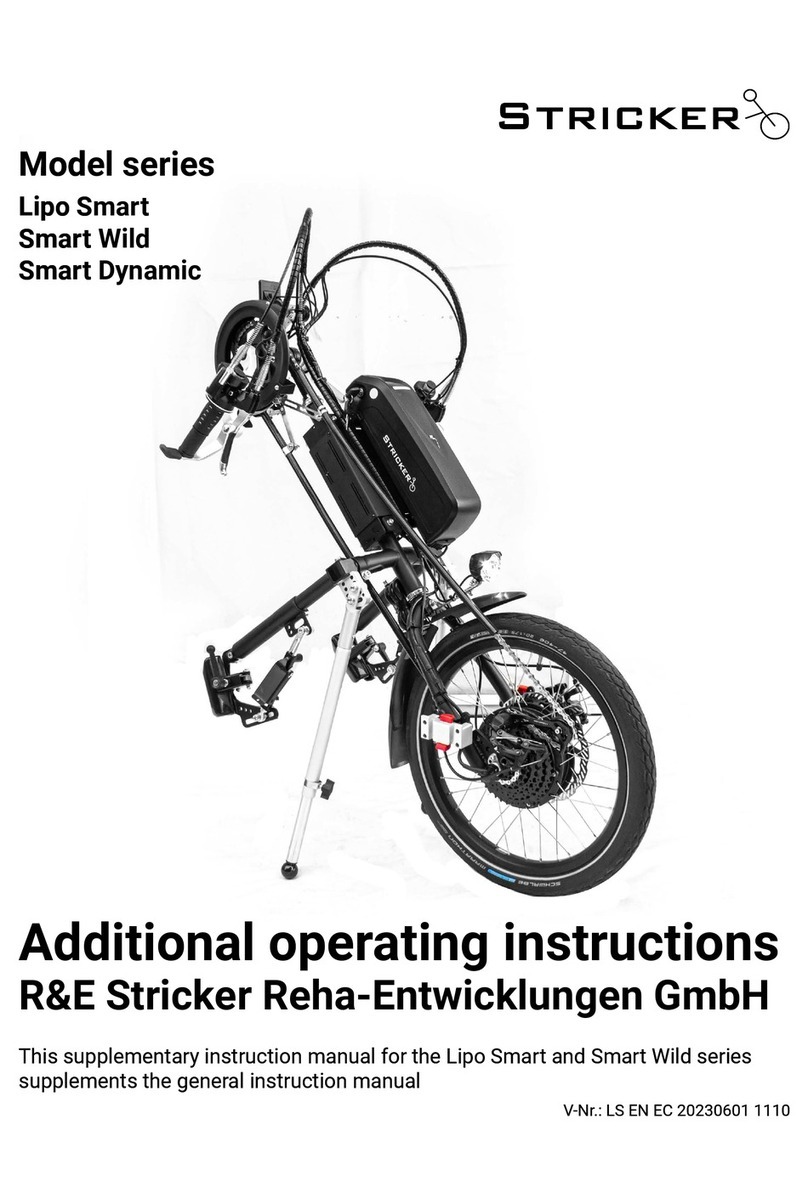
Stricker
Stricker Lipo Smart Series Operating instructions
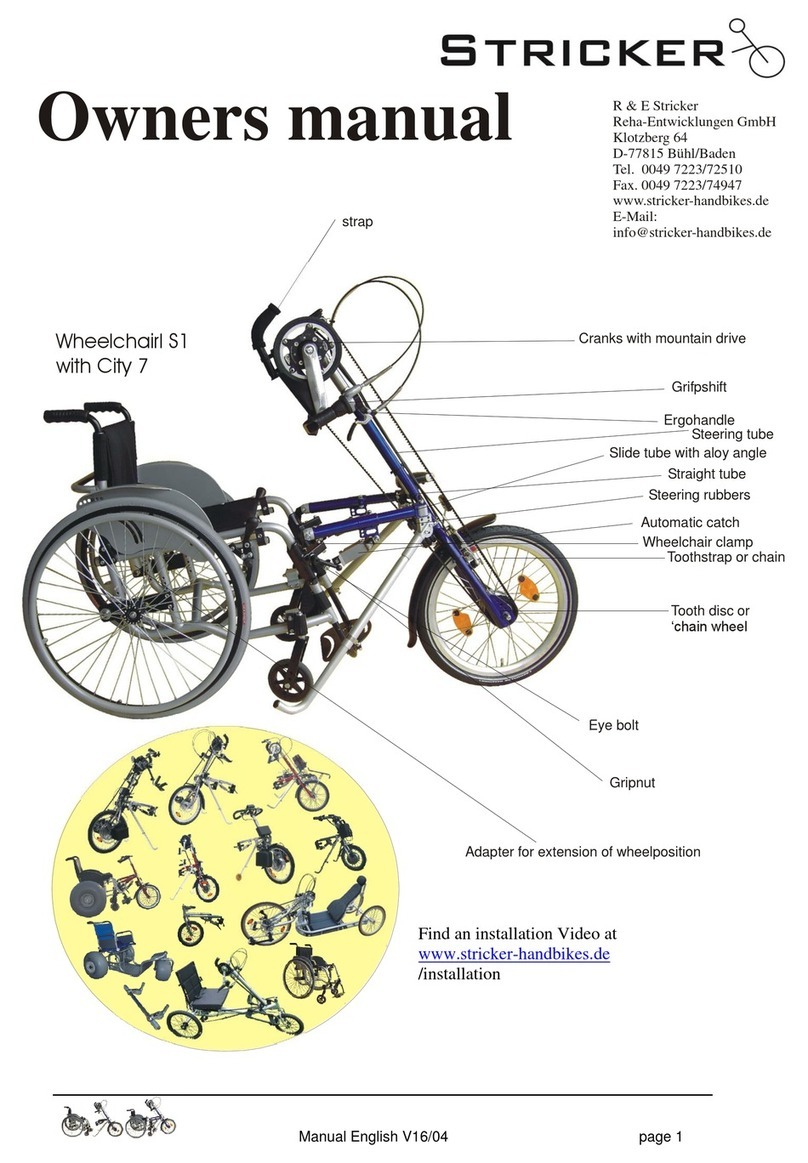
Stricker
Stricker CITY 7 User manual
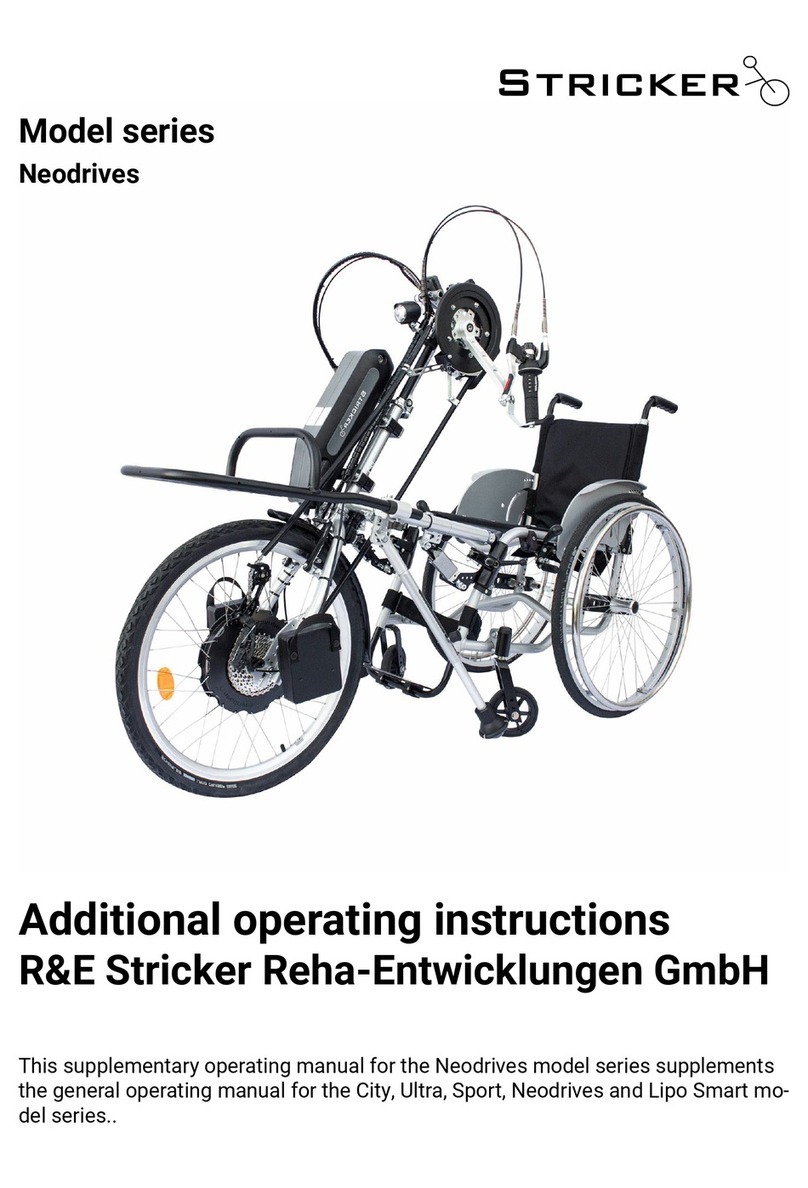
Stricker
Stricker Neodrives Operating instructions
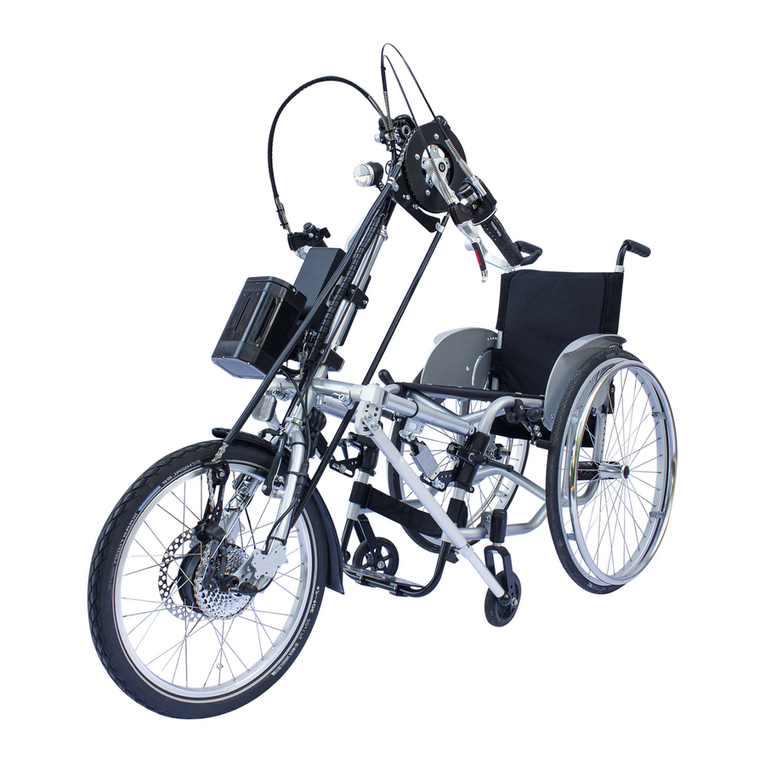
Stricker
Stricker Lipo Smart Series Operating instructions

Stricker
Stricker City User manual
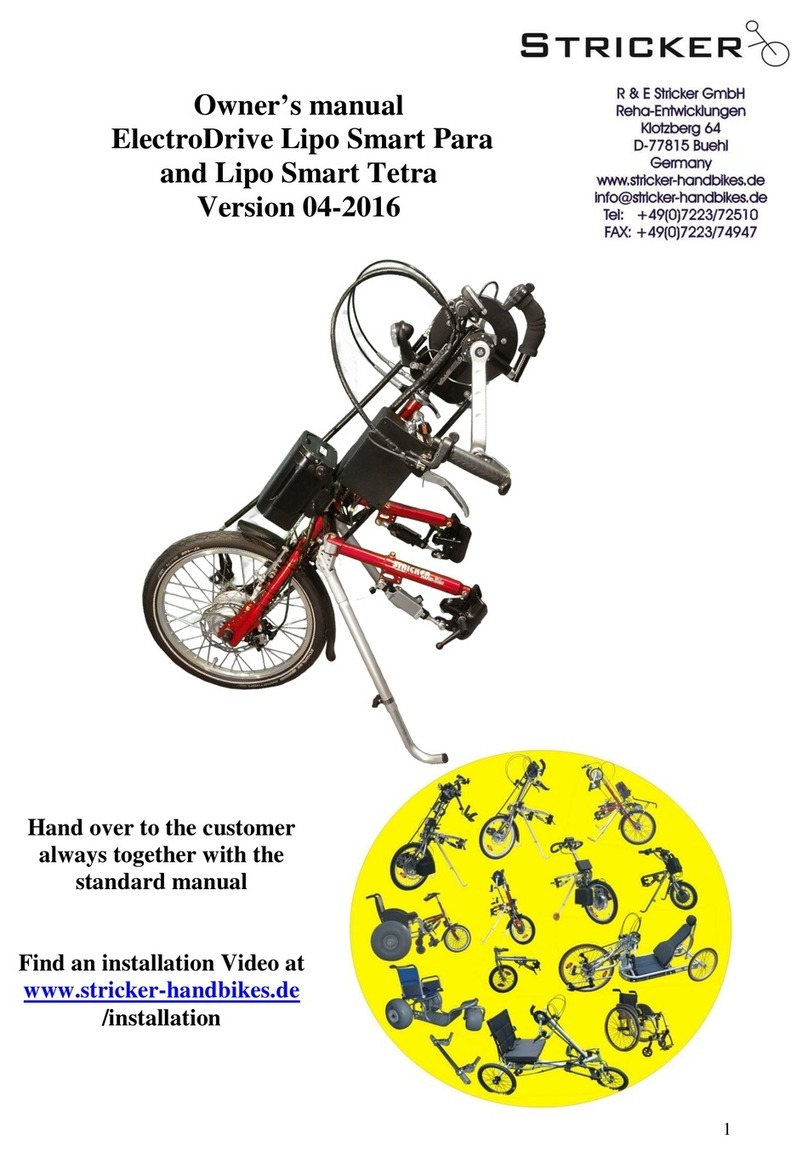
Stricker
Stricker Lipo Smart Para User manual
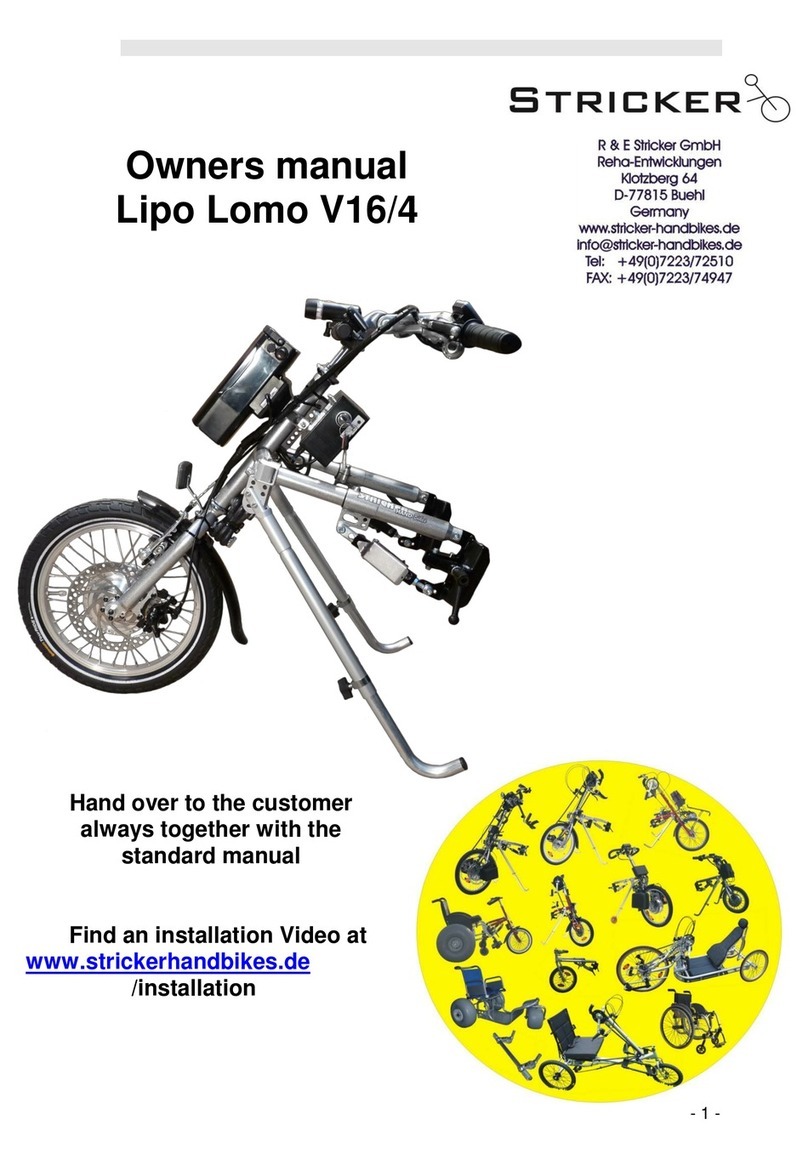
Stricker
Stricker Lipo Lomo V16/4 User manual
